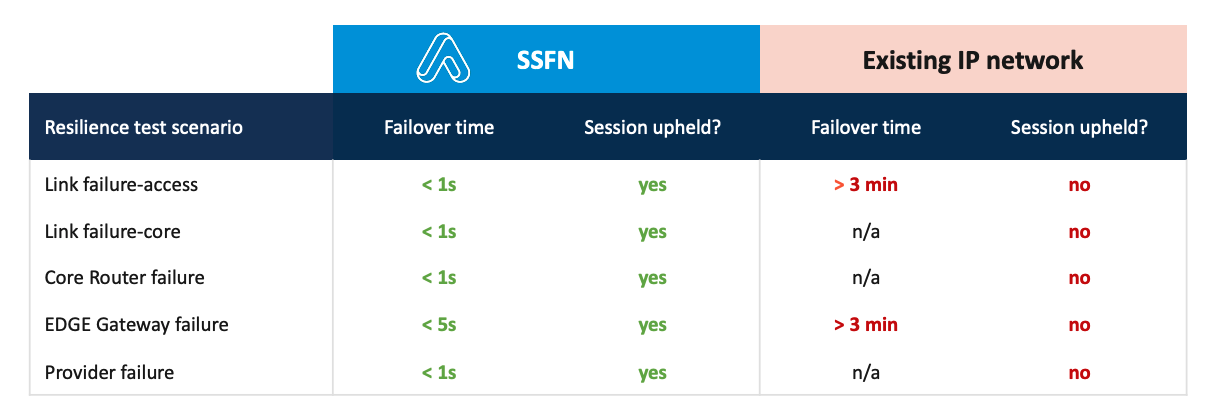Network reliability is not just a buzzword; it is the lifeline of our digital society. Businesses, governments, and individuals all rely on seamless communication and nonstop data flow, with critical services running around the clock.
Imagine the consequences of a network failure during a critical financial transaction, while monitoring the operation of a power grid, or even when you need to make a life-saving emergency phone call. The stakes are undeniably high.
In this article, we explore the concept of network reliability, its far-reaching impact on critical infrastructures, and how SCION, a cutting-edge networking approach, is rewriting the rules of dependable network connectivity.
Let's dive in and see how Anapaya's solution tackles network reliability challenges head-on.
Defining reliability and availability in network communication
According to TechTarget, network reliability is the measure of the length of time infrastructure operates without disruption. In simpler terms, it's the umbilical cord of a network – ensuring that data is transmitted accurately and efficiently between devices without interruption.
At its core, reliability addresses the question: "Can the network consistently perform at a high level and deliver expected results?" It's a crucial consideration for any network, and it becomes even more critical in the face of increasing cyber threats, natural disasters, or human error.
Unlike network reliability, availability is the percentage of time the infrastructure is operational during a given time frame. As a basic equation, availability is uptime divided by total service time. For instance, a network with an uptime of 99.9% would be considered highly available but not necessarily reliable if it experiences frequent disruptions during that 0.1% downtime.
That 99.9% may look good on paper, but over the course of a year, it equates to more than 8 hours of downtime – a significant impact on any business or organization that relies on a stable network.
Reliability and availability, while distinct in their definitions, are intrinsically linked when it comes to network performance. Essentially, they are two sides of the same coin. A highly reliable network is likely to enhance overall availability. On the other hand, a network with high availability may not always be reliable if it faces frequent, although short, disruptions. Hence, an optimal balance between the two is crucial for maintaining a healthy, resilient, and efficiently performing network infrastructure.
Critical infrastructure operations, including water treatment facilities, hydroelectric dams, and energy generation, distribution, and transmission organizations, rely on a highly reliable and secure network, also referred to as Five Nines (99.999%). Five nines represent an extremely high availability of 99.999% uptime, with downtime of just 5.26 minutes per year, and it's typically required for services where any disruption is unacceptable, such as emergency services or financial transactions.
The impact of network reliability on critical infrastructures
Let's take a look at some examples where internet outages and downtime have had a negative impact on the operations of critical infrastructures. Critical infrastructure, as defined by the Cybersecurity & Infrastructure Security Agency (CISA), encompasses assets, systems, and networks essential for sustaining our daily activities.
CISA has outlined 16 sectors within critical infrastructure, recognizing them as crucial to the extent that their impairment or destruction would result in severe consequences for national security, the economy, and public health or safety. These include power grids, transportation networks, healthcare facilities, financial systems, and more.
The financial sector is highly dependent on network reliability. Trading platforms, electronic banking, and transactions worth billions of dollars occur daily on networks. Even the slightest network disruption can result in substantial financial losses and erode market confidence.
One notable example of a bank suffering from an outage is the incident that hit HSBC just a few days ago. In November 2023, HSBC, one of the world's largest banking and financial services organizations, experienced a major outage that left thousands of its UK customers unable to access their mobile and online banking services for over 24 hours.
The same bank suffered a major outage due to a DDoS attack in 2016, and an additional four mobile and online banking disruptions, with outages logged on 6, 16, and 18 November 2018. These incidents underscore the critical importance of network reliability in the financial sector, demonstrating how a single disruption can affect thousands of people and potentially cause significant financial losses.
Healthcare, another critical industry, has not been immune to disruptions either, and in this case, network reliability can truly be a matter of life and death. The sector is increasingly becoming a target for cyberattacks, a trend underscored by a recent DDoS attack on several public healthcare institutions in Singapore.
Orchestrated by flooding servers with excessive requests, this cyberassault disrupted internet connectivity for over seven hours, hindering access to email and productivity tools. Despite the attack, the agency responsible for IT operations in these institutions, Synapxe, confirmed that mission-critical systems supporting clinical services, patient records, and internal networks were not compromised.
This incident, however, overwhelmed the firewall, rendering all services depending on online connectivity inaccessible. This incident highlights the vulnerability of healthcare networks and the need for robust cybersecurity measures to safeguard critical systems and protect patient data.
Reliability with Anapaya’s SCION-based products
Unlike the Internet's original design, SCION is engineered to deal with today's complex and dynamic network environment, where constant connectivity and the secure exchange of data have become paramount.The SCION protocol unlocks multi-path communication, allowing traffic routing via multiple paths simultaneously. This guarantees high availability, reserved global bandwidth, and dynamic traffic optimization.
- Multi-pathing - The SCION protocol offers multiple path options for uninterrupted network connectivity, minimizing the risk of downtime.
- Quick path switch - In the event of a path failure or congestion, the SCION protocol allows for sub-second path switching, ensuring minimal disruption to network operations.
- Dynamic traffic optimization - SCION dynamically shifts resources to where they're needed most, making congested networks a thing of the past.
But SCION's reliability is not just a theoretical concept; it has been rigorously tested to ensure its performance in real-world scenarios. Our comparison of the SCION-powered Secure Swiss Finance Network or SSFN with the existing IP network, which operates on a redundant MPLS-based infrastructure.
Our observations highlighted significant disparities in failover times and the impact on application-level continuity. The existing IP network showed longer failover times, often exceeding several minutes, and most importantly, application sessions experienced interruptions, affecting their stability.
SCION's ability to integrate multiple service providers and exercise sender path control enables swift transitions to operational paths, as shown in the image below.

Anapaya Systems is at the forefront of leveraging the SCION protocol to revolutionize the internet as we know it. It offers a comprehensive suite of products that empower organizations with resilient, secure, and efficient network infrastructures.
Anapaya CORE installed at the ISPs forms the backbone of the SCION internet. To offer access to the SCION-Internet, service providers need to install Anapaya CORE.
Once Anapaya CORE is installed within a service provider, their clients can access and use the SCION-Internet via Anapaya EDGE, which is the end-user gateway to access the SCION-Internet.
The Anapaya GATE is a powerful gateway installed in the ISP backbone to collect traffic from diverse sources, including remote workforces. With real-time failover features, geofencing capabilities, and boosted cloud connections, Anapaya GATE guarantees business continuity and improves your data protection policies.
Conclusion
The reliability of critical infrastructure has become an international priority. The challenges we face in safeguarding our critical infrastructures can only be tackled by adopting alternative networking solutions that prioritize reliability. This is where SCION and Anapaya come in, providing a robust and resilient network architecture that meets the demands of critical infrastructure operators.
To stay informed about the latest developments in network reliability, security, and the protection of critical infrastructure, we invite you to subscribe to our newsletter and join our community today.





.png?width=380&name=Image%20(11).png)




